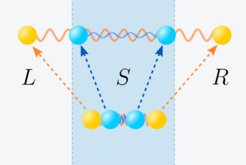Quantum systems out of equilibrium
Researchers develop a novel tensor network approach to simulate the evolution of quantum many body systems over time.
Theorists in the research group of Mari Carmen Bañuls at MPQ have come one step closer to understanding the evolution of quantum many body systems over time. In their work, recently published in the specialized journal Physical Review Letters, they formulated an algorithm to simulate the dynamics of quantum systems consisting of many particles out of equilibrium – a notoriously difficult task, but one with strong scientific potential for condensed matter physics and the understanding and potential fabrication of novel and exotic materials.

Predicting the evolution of a quantum many-body system out of equilibrium is a notoriously difficult problem, even if one is only interested in local properties. Being able to make these predictions, however, has both practical and theoretical implications. On the practical side, being able to carry out these simulations allows one to understand how quantum systems react to external perturbations or how excitations on them are transported throughout the system. These are relevant questions in the field of condensed matter physics, and progress can lead to the design of materials with new, exotic or desired properties. At the same time, it is interesting to understand from a theoretical point of view how and under what conditions quantum systems do thermalize.
What is meant by thermalization of quantum systems? Let us consider a thought experiment. Take two glasses of water, one hot and one cold, and pour both of them in a larger container. Common sense tells that shortly after, the water in the container will have a uniform lukewarm temperature, milder than the two initial temperatures. This phenomenon, known as thermalization, by which the state of the system after some time reaches a "thermal equilibrium" state described by a unique temperature, is also observed in quantum systems.
While classically, the dynamical mechanisms that induce thermalization are relatively well understood, in the quantum case there are still many open questions. What is known is that entanglement generated by quantum dynamics is crucial for the system to reach such thermal equilibrium. However, the same generation of entanglement turns our most powerful simulation techniques – based on tensor networks – helpless to reach the long-time scales necessary for thermalization.
Tensor networks are factorizations of very large tensors – a tensor is a mathematical object that can be used to describe physical properties – into networks of smaller tensors, with applications in applied mathematics, chemistry, physics, machine learning, and other fields. These tensor networks are a powerful tool to obtain efficient descriptions of the state of many quantum particles and they excel when the state they represent has low entanglement, or to be precise: when the states represented satisfy an area-law of entanglement. However, the evolution over time of a quantum system will generate so much entanglement that it will eventually violate this law, and hence can’t be adequately represented by tensor networks any longer.

In their recent work, the theorists from MPQ in collaboration with Luca Tagliacozzo, researcher at the CSIC – the largest public research association in Spain – have therefore developed a new idea to overcome this obstacle. They developed a new algorithm that now allows them to actively convert the dynamically generated entanglement into the „thermal“ description of their simulations. This allows to numerically simulate the systems over long periods of time – considerably longer than it was possible before – while accurately following the behavior of the system's constituents, until equilibration is reached.
“At the moment our technique only allows us to tackle one-dimensional systems where the particles are confined to move in a line. However, even something as simple as keeping track of the evolution of those systems has been a huge problem for many years. Ideally, in the future, we could tackle systems where the particles are arranged in less restricted geometries or when they interact with each other in different ways to the ones we have considered now”, says Miguel Frías-Pérez, Doctoral Candidate in the group of Mari Carmen Bañuls.
“We hope that the ideas that we introduce will help understand the thermalization of those quantum systems and inspire new algorithms that could perhaps soon tackle more general scenarios and contribute to solving some of the current challenges of condensed matter physics dealing with the dynamics of quantum systems”, the researcher adds.













